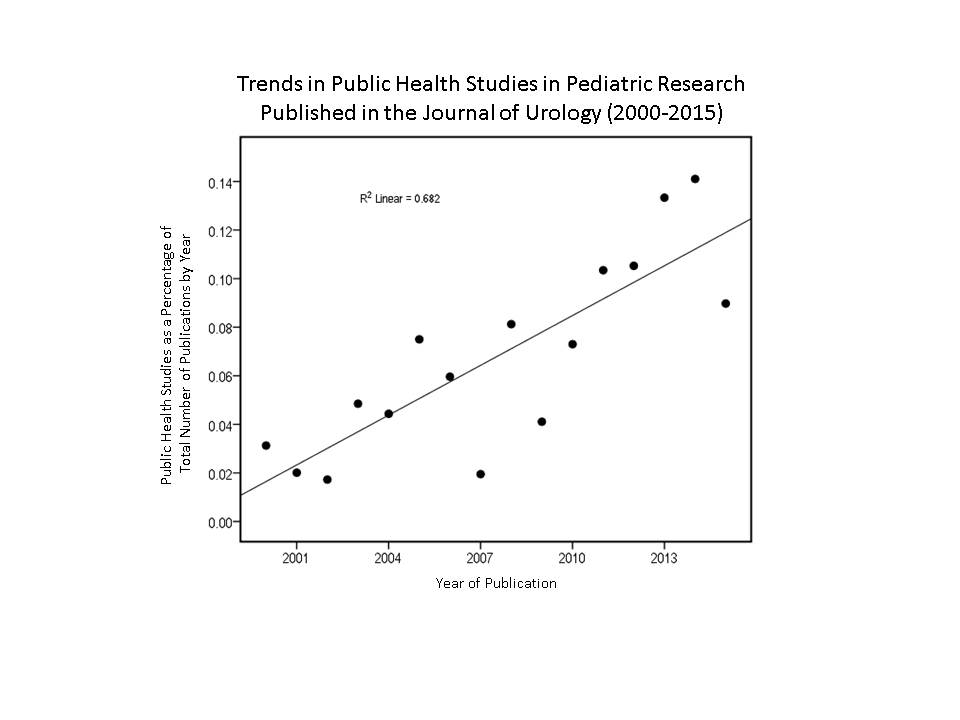A 15-Year Review of the Pediatric Urologic Literature—Is Innovation Declining?
Eric Nelson, MD1, Melinda Carpenter, MS2, Jason K. Frankel, MD3, Katherine W. Herbst, MS2.
1Division of Urology,Connecticut Children's Medical Center/ Department of Surgery, University of Connecticut Health Center, Hartford, CT, USA, 2Divisions of Urology and Nephrology, and Department of Research, Connecticut Children's Medical Center, Hartford, CT, USA, 3Department of Surgery,University of Connecticut Health Center, Farmington, CT, USA.
BACKGROUND
Surgical innovation is critical to the growth and success of the pediatric urology specialty. It was our impression that papers published recently have focused less on new techniques and management and more on public health issues. We hypothesized that literature describing novel techniques and management strategies are diminishing over time.
METHODS
All pediatric research articles published between 2000 and 2015 in the Journal of Urology were reviewed. Abstracts published in supplements without full manuscripts were excluded from the study. The review team included two MDs—one pediatric urologist, one urology resident, and two research professionals with Master of Science (MS) degrees. Two teams were created with a MD and a MS on each, and years assigned to each team based on even or odd years. Agreement between pair members was determined and non-accordance resolved by a third team member. Articles were categorized broadly into “clinical,” “basic science,” and “public health” groups. Clinical manuscripts were further designated as “diagnosis” or “treatment” focused. Manuscripts with a treatment focus were classified as “novel” if this was the first description of a technique/treatment or a novel modification of an existing one. Manuscripts were excluded if there was ever any description of the particular technique noted by the authors elsewhere in the literature. Papers were categorized as “public health” if health care systems, cost, or epidemiology were the primary aim. Linear regression statistical analysis was then applied.
RESULTS
Over the 15-year study period, 2,297 manuscripts were published in the Journal of Urology. The majority of manuscripts (83.7%/1,923) were studies regarding clinical topics, with 10.2% (234) reporting basic science data and 6.1% (140) focusing on public health issues. Linear regression shows a significant trend in the reduction of the number of manuscripts reporting a new surgical technique over the study period (p<0.001, R2=0.78, R=0.88) (Figure 1). A significant trend was also found when analyzed as a percent of the number of manuscripts published each year (p<0.001, R2=0.61, R=0.78). The opposite was true for public health manuscripts. The number of public health papers increased over the years (p<0.05, r2=.33, r=.058). Even more dramatically, the number of public health papers as a percentage of total publications per year increased (p<0.001, r=0.83, r2=0.68) (Figure 2).
CONCLUSIONS
Over the last 15 years, we have a seen a steady decline in the number of “novel” techniques described in the literature. The reasons for this trend are unclear—clinical research restrictions and concerns for liability might play a role. Further introspection within our specialty and research into these trends seems reasonable so that we can continue to innovate and evolve.

Back to 2016 Fall Congress
